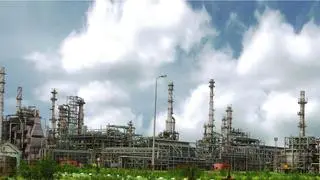Finding 350 million tonnes of oil and gas means a lot for any oil company, even if only a seventh of it can be taken out. Officials at ONGC are thus understandably upbeat about their newfound ability to produce oil and gas from tough reservoirs they knew held these resources.
When it comes to hydrocarbons, the deeper you go, the tougher it gets. There are some reservoirs — oil or gas bearing zones of rock and sand — that are at unmanageably high pressures (HP), or high temperatures (HT), or both. These are ‘HPHT’ reservoirs and petroleum engineers have been eyeing these reservoirs the way a cat eyes fish in a glass tank.
And then there are ‘tight’ reservoirs. These hold a lot of hydrocarbons but are not very ‘permeable’ — they do not allow the hydrocarbons to flow. Usually, you sink a well (which is really a tube) into the reservoir and create a low pressure. Since the oil or gas is at high pressure it flows towards the low-pressure tube and then gushes out. But if the zone is not permeable it cannot flow. No flow means no oil, and no gas.
To tame these reservoirs, oilmen crack open the recalcitrant rocks using a technique called ‘fracking’, a term usually heard in the context of shale. They send down a mixture of a special jelly and tiny, mustard-like grits called proppents at very high pressures. The high-pressure jelly creates cracks in the rocks and the proppents lodge themselves in the cracks and prevent them from closing. After some time the jelly turns watery and is drained out. The reservoir is thus tapped.
ONGC had identified several HPHT and ‘tight’ reservoirs in India, but did not have the technology to produce hydrocarbons from them. Among other challenges, a high temperature reservoir is at least 350 F hot, nearly twice as hot as boiling water, making it difficult to introduce electronic logging equipment in it. But now, equipment companies such as Schlumberger have developed technologies and contrivances to dip into such tough reservoirs.
Centre of delivery
In November 2012, ONGC created a ‘Centre of Delivery’ for HPHT and ‘tight’ reservoirs. The Centre is headquartered in Chennai, because the eight fields identified are in the South — five in the Krishna-Godavari basin and three in the Cauvery basin. Incidentally, ONGC has created similar centres for shale oil and gas (Vadodara) and coal-bed methane (Dehradun).
P. Raja, General Manager, ONGC and the Head of the CoD for HPHT and tight reservoirs, believes seven of these oilfields in the South hold 350 million tonnes of oil or oil-equivalent gas, but mostly gas. He believes that ultimately only 50 million tonnes can be produced with the technology now available.
The Centre aims to produce about 5 million tonnes from these reservoirs, which is akin to increasing the production of Bombay High by 25 per cent.
In the Cauvery basin, the first to go might be the one near Bhuvanagiri, which is both high pressure and ‘tight’. The oil-bearing zone is 400 metres thick, and occurs at a depth of 3.3 km. Another at Periyakudi, near Tiruvannamalai, was discovered two years ago. This one, nearly 5 km down, features all the three headaches — HP, HT and tight. But the oil-bearing zone is over half-a-kilometre thick. The third is a tight reservoir at Pallivaramangalam. The first two will go on stream in a year.
In the KG basin, three are on land and one in the shallow waters off Yanam.
All seven belong to ONGC. In addition, a joint venture between ONGC and Cairn discovered another tough reservoir located near Nagayalanga in Andhra Pradesh.







Comments
Comments have to be in English, and in full sentences. They cannot be abusive or personal. Please abide by our community guidelines for posting your comments.
We have migrated to a new commenting platform. If you are already a registered user of TheHindu Businessline and logged in, you may continue to engage with our articles. If you do not have an account please register and login to post comments. Users can access their older comments by logging into their accounts on Vuukle.